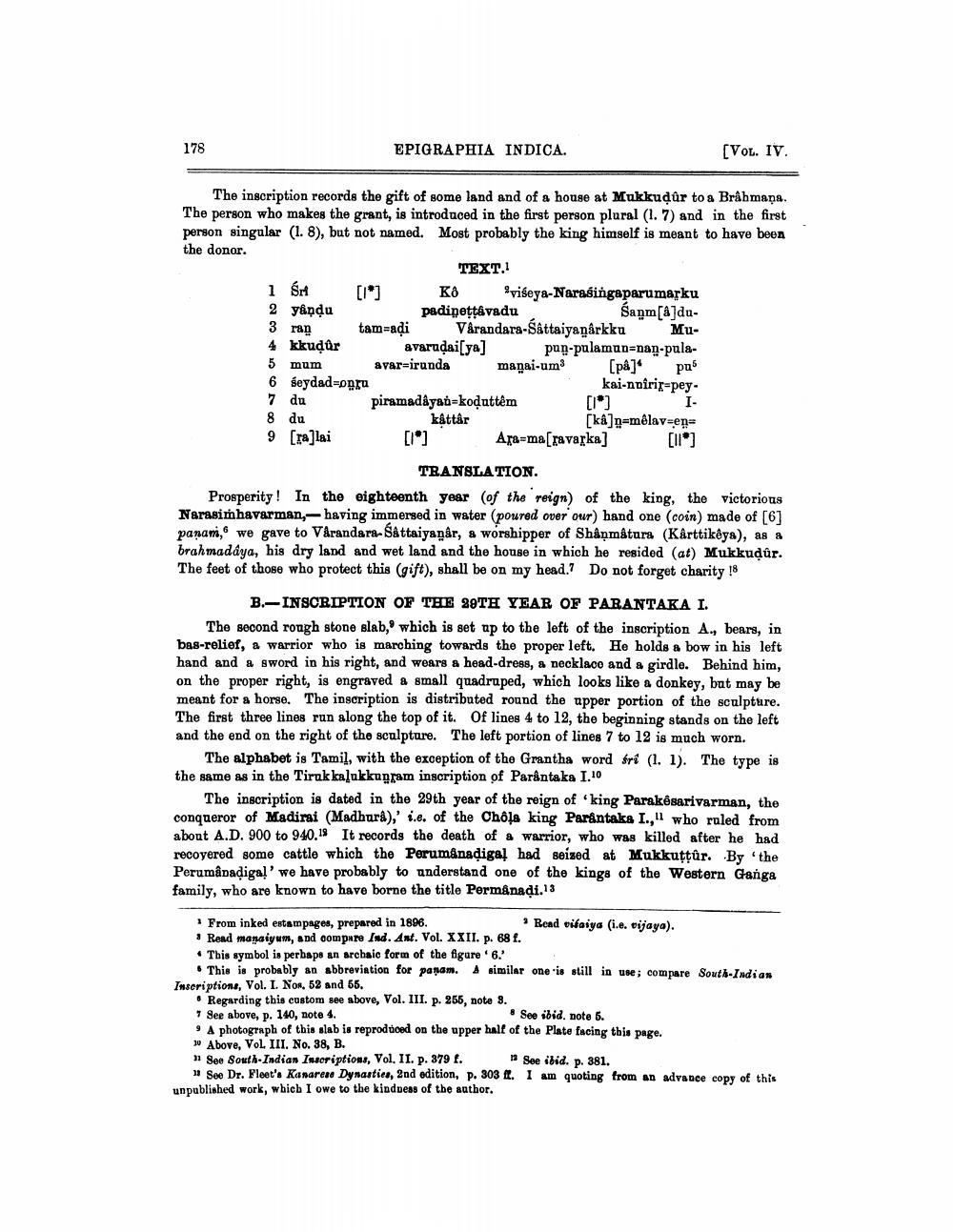________________
178
EPIGRAPHIA INDICA.
(VOL. IV.
The inscription records the gift of some land and of a house at Mukkudûr to a Brahmans. The person who makes the grant, is introduced in the first person plural (1.7) and in the first person singular (1.8), but not named. Most probably the king himself is meant to have been the donor.
TEXT. 1 ŚH [1*] K8 vifoya-Narasingaparumarku 2 yându padipettávadu
Sanm[á]du3 ran tam-adi Vårandara-Sattaiyaņarkku Mu4 kkudur avarudai[y] pun-pulaman-nan-pula5 mum avarsirunda manai-um (på]* pus 6 seydad=onru
kai-nniris-pey. 7 du piramadâyankoduttêm
I. 8 du kâttâr
[kâ]n=mêlav=en= 9 [ra]lai [1] Ara=ma[ravarka]
TRANSLATION. Prosperity! In the eighteenth year of the reign of the king, the victorious Narasimhavarman,- having immersed in water (poured over our) hand one (coin) made of [6] panami, we gave to Vårandara-Sattaiyagår, & worshipper of Shâņmatura (Kârttikêya), as a brahmadaya, his dry land and wet land and the house in which he resided (at) Mukkudûr. The feet of those who protect this (gift), shall be on my head. Do not forget charity 18
B-INSCRIPTION OF THE 20TH YEAR OF PARANTAKA I. The second rough stone slab, which is set up to the left of the inscription A., bears, in bas-relief, a warrior who is marching towards the proper left. He holds a bow in his left hand and a sword in his right, and wears a head-dress, a necklace and a girdle. Behind him, on the proper right, is engraved a small quadruped, which looks like a donkey, but may be meant for a horse. The inscription is distributed round the upper portion of the sculpture. The first three lines run along the top of it. Of lines 4 to 12, the beginning stands on the left and the end on the right of the sculpture. The left portion of lines 7 to 12 is much worn.
The alphabet is Tamil, with the exception of the Grantha word sri (1. 1). The type is the same as in the Tirukkalukkugram inscription of Parantaka 1.10
The inscription is dated in the 29th year of the reign of 'king Parakesarivarman, the conqueror of Madirai (Madhurd),' i.e. of the Chola king Parantaka I.," who ruled from about A.D. 900 to 940.18 It records the death of a warrior, who was killed after he had recovered some cattle which the Perumånadiga! had seized at Mukkuttur. By the Perumânadiga!' we have probably to understand one of the kings of the Western Ganga family, who are known to have borne the title Permånadi.13
* From inked estampages, prepared in 1896.
• Read vilaiya (i.e. vijaya). . Read manaiyum, and compare Ind. Ant. Vol. XXII. p. 68 f. • This symbol is perhaps an archaic form of the figure 6.
• This is probably an abbreviation for panam. A similar one is still in use; compare South Indian Inscriptions, Vol. I Nor. 52 and 65.
• Regarding this custom see above, Vol. III. p. 256, note 8. 7 See above, p. 140, note 4.
See ibid. note 6. A photograph of this slab is reproduced on the upper half of the Plate facing this page. » Above, VOL III. No. 38, B. n See South Indian Inscriptions, Vol. II. p. 379 f.
See ibid. p. 381. Soe Dr. Fleet's Kanaren Dynasties, 2nd edition, p. 303 L. I am quoting from an advance copy of this unpublished work, which I owe to the kindness of the author.




